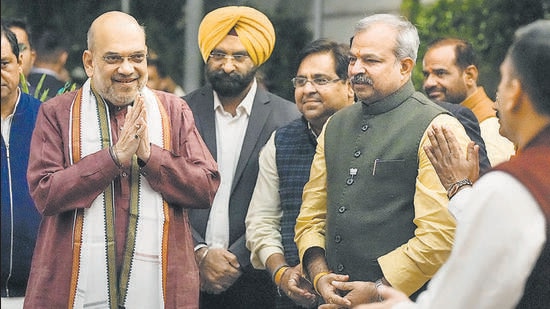Four lessons from the BJP’s ceaseless Gujarat dominance
Retaining power in Gujarat with a clear mandate has always been a priority for the BJP. And there are lessons to be drawn from the BJP’s election history in the state
It was the much-touted Gujarat model of development that caught voters’ attention and dominated the election narrative in 2013 when the Bharatiya Janata Party (BJP) announced the candidature of Narendra Modi for the Prime Minister’s post.

Modi, who by then had been the chief minister of the state for 12 years and a bit, was positioned as a change-maker, harbinger of development, and an administrator who changed the face of Gujarat, resurrecting the tremor-ravaged Bhuj with speed and efficiency. There was talk of big money too, investments and industries, exports and economy and how the ordinary Gujarati led a life far more comfortable than their counterparts in other states.
Also Read | Angry young men of 2017 expand electoral influence in Gujarat
The blot of the 2002 riots, simmering anger in certain pockets and embarrassing indices to show lack of quality health care and education were brushed away as aberrations and the 2014 general elections saw the BJP storm to power at the Centre with a brute majority.
Gujarat was the template on which the BJP positioned its project of building a new India.
Therefore, retaining power in Gujarat with a clear mandate has always been a priority for the BJP. And there are lessons to be drawn from the BJP’s election history in the state.
First, never rest on your laurels.
The poor showing in 2017, when the BJP won just 99 of 182 seats was a jolt that nudged the party to reorganise for the 2022 polls and prepare to tackle not just the traditional rival in the state, the Congress, but also pre-empt any encroachment of its vote bank by the Aam Admi Party (AAP), a new entrant in the fray.
Through its big win on Thursday, it conveyed that even in constituencies where the BJP is a clear favourite, the party does not let its guard down and there is no let-up in outreach to improve the vote and seat share.
It is for the first time that the party garnered over 50% of the total votes polled, a target that had been set by former party president Amit Shah during his presidency.
The second takeaway is the need to cultivate state leaders.
The euphoria of Thursday’s 156-seat win in Gujarat has been dampened by the loss in Himachal Pradesh and in two of the three constituencies in Uttar Pradesh where bypolls were held. Though party leaders assert that the clear mandate in Gujarat is a testament to the undiminished popularity of PM Modi, which insulates the BJP from simmering issues that can dent its performance and acts like a shield against attacks from the Opposition, the same cannot be said for the outcome in Himachal.
While Modi is a force multiplier, the credit for victory in Gujarat, party leaders said, also rests to a large extent on Union home minister Amit Shah’s meticulous planning and the ground work done by the BJP’s state president CR Paatil, who took charge in 2020.
“This election has proved that the BJP’s leadership line-up is also formidable. Shah, who was essentially seen as a behind-the-scenes strategist, has now emerged as a campaigner to reckon with. With 35 rallies and two roadshows under his belt; he has established that he is as good a planner and architect as a crowd-puller,” said a second party functionary.
The third takeaway is that bipolar fights are a challenge for the BJP.
The loss in Himachal shows that in a bipolar contest where the opponent is redoubtable, the BJP can be challenged — especially when the state unit is weak and relies on the central leadership and Modi’s charisma.
The state unit’s internal wrangling and weak leadership was identified as one of the key reasons for the party not being able to retain power. This should sound a note of caution for the party that is gearing to contest elections in Madhya Pradesh and Rajasthan, where contests are typically bipolar and in Karnataka where the party’s government has had to face a flurry of challenges.
The last learning is the BJP’s ability to manoeuvre the election discourse.
The party successively managed to drown out criticism about its economic policies, and the soaring prices of essentials that hurt the common man. It leveraged the work done by the Union government in carrying out a massive vaccination drive in the wake of the Covid-19 pandemic, and the scheme to provide free foodgrain and other social welfare measures to dull the pain inflicted by escalating prices and job cuts.
But the Congress’s ability to sway the mood in Himachal based on economic issues, such as its promise of returning to the old pension scheme, underpin the extent to which local issues can be subsumed in the larger national discourse.
Constant references by the BJP leadership to ideological issues, the Ram Mandir, the abrogation of Article 370 in Jammu & Kashmir and its vocal support for implementing the Uniform Civil Code also show that as far as the Hindutva plank goes, there is no law of diminishing returns.
Continue reading with HT Premium Subscription





